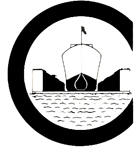Over 150 years of expertise in marine railways and floating dry docks
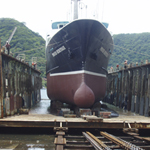 |
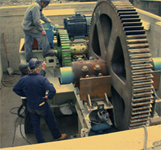 |
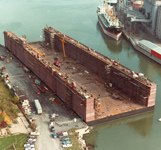 |
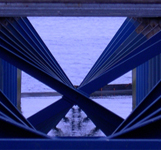 |
|
The Crandall Dry Dock Engineers Story
1848-2007
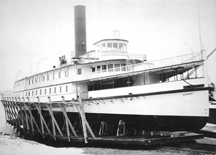 |
The William Hazard branch of the Crandall family settled in Newport, Rhode Island about 1840. They lived on Poplar Street and William Hazard Crandall owned a shipyard in what was later to be called Long Wharf. During this period, he constructed his own marine railway using steam power, wrought iron chain and crude iron rollers to haul vessels out for repairs. This was an era of tremendous coastwise and transatlantic shipping since there were few railroads and no roads of consequence. The coasting ships were sailing vessels, some with steam power of very modest tonnage and so well suited to the marine railway concept. Fourteen years later, in 1854, W. H. Crandall and his son, Horace Irving Crandall, were asked by the Boston Dry Dock Company to build a dock of the marine railway type in East Boston for the unprecedented capacity of 1000 tons based on the great success of their Newport dock. So, about this period the ship repair yard in Newport was sold to what became the Fall River Line as a terminus for passengers going to New York. The new railway, in what was to become the Atlantic works of the Bethlehem Steel Company, was so successful that eventually three more were built in capacities of 1500, 2000 and 2500 tons, and they continued to be used until about 1970 when the lack of business caused the yard to close. Additional marine railways were built along Chelsea Creek about the turn of the century. In 1862, H.I. Crandall was in Great Britain where he probably went to purchase hauling chains and machinery since England was a leading supplier to North America in metal products and machines. Not long thereafter, he took his family to live in Dartmouth, Nova Scotia, across from Halifax. It was in Dartmouth that his son, James Lyle Crandall, grew up and eventually married Carrie Stuart from St. John, New Brunswick. A great many marine railways were built in Canada at this time, among them were installations in North Sydney and Pictou in 1860, Dartmouth in 1862, and Lunenburg and Port Hawkesbury in 1864. In the meantime, H.I. Crandall traveled all over the eastern seaboard, to the West Coast, to South America, and even to the Philippines where CRANDALL docks were constructed. He was joined by his son, James Lyle, in 1888. In 1890, at the age of 24, James Lyle built his first of four railways at St. Pierre et Miquelon where he and his wife had honeymooned. One year later, James Stuart Crandall was born in Dartmouth on Ocherloney Street. By the end of 1891 the family had moved to Boston where business was carried on under the name of H.I. Crandall and Son in spaced rented in the Atlantic Works Shipyard in East Boston. Before this, railways well over 1000-ton capacity had been built in Uruguay, Honolulu, Portland and Bath, Maine, and elsewhere by H.I. Crandall, himself. By the year 1900, three docks of 2000 tons, three of 2500 tons, two of 3000 tons and one 4000 tons had been built using wrought iron chains, timber cradles and timber track bearing on timber piles. Almost every East Coast Harbor of the U.S. and Canada had one or more operating CRANDALL railway. World War I was a period of enormous dry dock growth. After 1900, James Lyle Crandall developed the CRANDALL sectional floating dry docks constructed of timber, but stiffened by longitudinal Warren trusses designed with pin-connected joints to permit self-docking but also permitting the dock to be rigid once connected. This development was applied to many new docks being built by the U.S. Shipping Board and by the Navy Bureau of Yards and Docks. It was then that James Lyle became consultant to both of these U.S. government agencies. Again, it is important to understand that sea transport was flourishing, the automobile in its infancy and only the railroads were truly a coastwise competitor. Also ships were for the most part less then 8000 tons light displacement with a great many less than 2000 tons. With the war over, ship repair was in demand and so harbors like Boston, New York, Philadelphia, Baltimore and Norfolk were busy in Ship maintenance. Then gradually as roads and automobiles developed, plus with the increased use of heating oil instead of coal, medium tankers and barges began their regular runs from the Texas ports up to New England by the Intracoastal Waterway. This generated considerable ship repair work in Norfolk and Jacksonville, such that demand for newer, larger docks increased. The basic success of the CRANDALL marine railway dry dock stemmed from their simplicity of operation with minimum manpower, the use of various types of releasing bilge blocks to permit speedy hull cleaning and painting without multiple dockings, and an operation taking about one hour at most, permitting one to take advantage of tides. Each generation of the Crandalls contributed new ideas for both design and construction taking advantage of new materials of construction to cope with the always-present struggle to beat the hostile elements of corrosion and marine borers, ice, wind, current, electrolysis and neglect. So invention and innovation were constantly demanded. After graduating from the University of Maine in 1915, J. Stuart Crandall joined his father and worked in the field building two docks in Cuba. It was about this time that Stuart with his engineering education conceived the idea of building railways with vertically curved tracks to better cope with grounding vessel instability and the need for horizontal transfer. After two years of military service he returned home where he was occupied as engineering of design until the bleak period of the Great Depression. Of course the Great Depression after 1929 brought new dock construction to a new ebb and very little could be done along the Atlantic seaboard. It was then that J. Stuart, following his service in the Corps of Engineers in France returned to Europe and succeeded after several years of effort to sell the Belgians and the French on using CRANDALL railway dry docks to dock the every growing fishing fleets at Ostend and Boulogne. These docks, built in 1931 and 1932 respectively are still in operation, having been almost totally rebuilt more than once. Great strides in engineering and product development resulted in adoption of structural steel versus timber framing, cast steel chains on sprockets made of heat-treated alloys versus the old wrought iron on mild steel. These post World War I improvements made it possible to build marine railways up to 8000 tons and a few were built using six or eight hauling chains. Similarly, there were important developments in foundation engineering so that greater load concentration capacities could be realized and machinery was being driven by electric power instead of steam. In 1935, James Lyle lost control of his Crandall Engineering Company whh had been founded in 1917, and Stuart along with his University of Maine classmates, Ray Lindgren and Vernon Hight left to form the firm of CRANDALL DRY DOCK ENGINEERS, INC. which now carries on the original tradition. Again, new docks in South America saved the day. Most of the staff of the old company, among them George Landrigan, James Garrett, Robie Harlow and others, joined the new company forming a solid and experienced team of dock designers and builders. In 1939 Great Britain and Canada were at war with Germany with the U.S. providing "lend lease" aid in the form of ships and war supplies. East coast Canadian ports were the shipping points and so a great demand was placed on Halifax and Montreal for both ship repair and new ship construction. From 1939 to 1945, twenty-one new CRANDALL docks were built in Maritime Canada alone, ranging from 200 tons for RCAF crash boats to 1400 tons for Corvettes to 3000 tons for Tribal class destroyers to 5000 tons for freighters and icebreakers. After December 1941, the U.S. shipyards were in full swing and this was an era when the U.S. Navy embarked on a huge floating dry dock program for overseas ship repair in far off theatres of operation. Therefore CRANDALL DRY DOCK ENGINEERS, due to their heavy commitment in Canada had to limit their U.S. Navy activity to floating docks in Curtis Bay, Norfolk, Jacksonville, New Orleans, and a number of marine railways in New Orleans, Norfolk and Miami. During this period James Lyle died in 1944 and the business was carried on under the direction of Stuart and his skilled team while his son, Paul S. Crandall, who had graduate from M.I.T. in 1942 was serving overseas with the U.S. Army Corps of Engineers. Returning from Europe in 1946, Paul Crandall joined the firm during the active post-war reconstruction and was assigned as field engineer to build in the Netherlands a special side haul railway for the reconstruction of the French Rhine fleet. Many existing docks required major rebuilding and restoration after the severe use and frequent overloading of the war years. Also there was activity overseas in the France, Belgium, the Persian Gulf and Argentina It was in 1952 that the first all-steel welded floating dry dock was designed and subsequently built in Buenos Aires, all on the metric system using overseas materials and equipment. After the sudden death of Stuart Crandall in 1953, world shipping began to change radically due to the Suez crisis which induced Japan to construct enormous tankers. Also it was a period when vessel enlargement was being done frequently to increase the vessel capacity. These developments made many dry docks, particularly basin docks, obsolete and so ushered in an important growth in floating dry dock projects. At the same time, the new heavy stern trawlers of Europe demanded docks of greater capacity, hence the construction at Boulogne and Zeebrugge of new CRANDALL railway dry docks. In the Pacific, too, the fishing fleets needed new docks in Tahiti, Samoa, and Port Moresby. Heavy trade with Japan and Alaska caused need for large docks on the U.S. and Canadian West Coast with the result that we designed the docks at Vancouver, British Columbia, and Portland, Oregon. In 1960 following a disastrous instability accident of the 8000-ton CRANDALL floating dry dock at Baltimore while attempting to lift the new ship Morimac Penn, Paul Crandall was asked by the shipyard president to train a new dockmaster. This two-week effort involved study and research into the general practice of ship docking and the naval architectural aspects of the combined ship and dock. Many U.S. shipyards then requested similar training and in the years following, seminars for dockmasters were held seventeen times over a span of 26 years with total attendance of about 650, some of whom traveled from as far away as Canada, Europe, Latin America and the South Pacific in order to attend. A "Dockmaster's Manual" was published from notes prepared for the various seminars held in such diverse locations as Boston, Norfolk, Mobile, Orlando, Savannah, Jacksonville, San Diego, Galveston, New Orleans, Portland, Oregon, and Halifax, Nova Scotia. The success and popularity of these ongoing seminars greatly increased worldwide recognition of CRANDALL DRY DOCK ENGINEERS, not only for design and construction of docks, but also as specialists in proper operation, maintenance and safety of ship docking. In 1960 Sun Shipbuilding in Chester, Pennsylvania, built the largest East Coast floating dock using a completely new mooring concept of flexible grippers with articulated joints capable of resisting hurricane forces. Since that time over a dozen large docks have used this CRANDALL invention which has been tested by actual hurricane winds on more than one occasion. The firm was fortunate to be selected to design several very large, welded steel floating docks for Litton-Pascagoula; New Orleans; Port of Portland, Oregon; Halifax, Nova Scotia; Vancouver, British Columbia; Alaska; and Newport News, Virginia, where transfer from shore berths was incorporated in the design. Several graduate engineers joined the firm to carry on the design of new docks and rehabilitation of older docks using modern technology. Crandall continues to be deeply involved in programs of damage stability and capacity certification to meet the ever-growing demands of the U.S. Navy. The company has undertaken from time to time a number of unusual projects and has joined on occasion with other Boston firms to participate in projects where Crandall expertise was required. Some of these projects included the rebuilding of the original Charles River Dam lock gate in wrought iron; the Washington, D.C. material handling pier for Metcalf & Eddy; the White Fuel Terminal and Union Oil Terminal with Haley & Aldrich, and the missile launch study for the U.S. Navy in collaboration with Lockheed. As an adjunct to marine railways, Crandall also designed ship launching systems on curved ways for Atlantic Dry Dock in Jacksonville; Hyundai in Korea; and others. It is interesting to note that during the economic downturn of the late 1980's for U.S. shipping, there continued to be a demand for small, medium sized docks and Crandall's business involved new marine railways in many cases. Crandall's adaptability for transfer makes them attractive every in this modern era. Crandall's adaptability for transfer makes them attractive especially in this modern era. Our most recent project (2006) at Point Hope Maritime features a circular transfer turntable with spurs radiating out so that multiple ships can be worked on simultaneously. |
Progress...the result of never being satisfied
Crandall
Dry Dock Engineers, Inc.
Established 1854
(888) DRYDOCK crandalldd@aol.com
